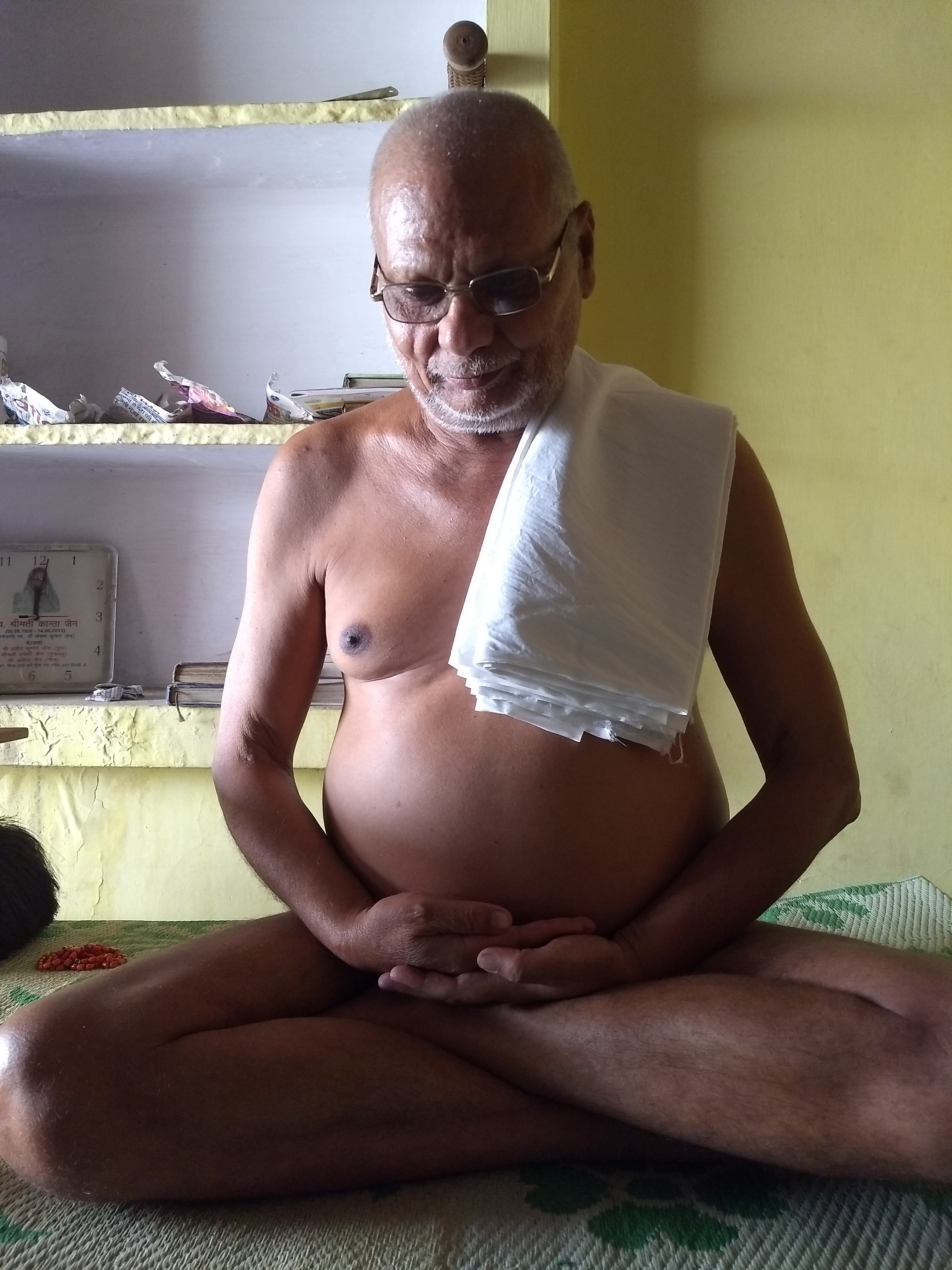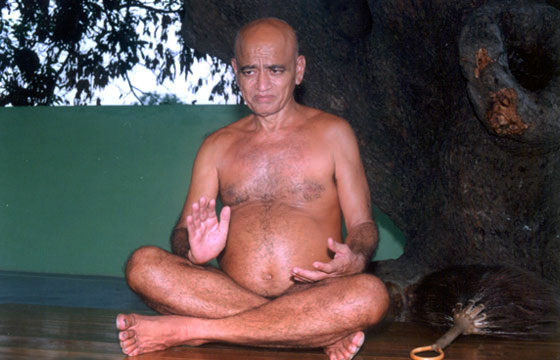|
Kshullaka
A kshullak (or kshullaka, lit. small or junior) is a junior Digambar Jain monk. A kshullak wears two garments as opposed to a full monk who wears no clothes.Jinendra Varni, Jainendra Siddhanta Kosa, V.2, pages, 188-189 Specifically a Kshullaka is a Shravaka of the highest degree at 11th Pratima. A kshullak is sometimes referred to by the earlier title Varni, even though Varni corresponds to the seventh Pratima. Well known kshullakas include: * Kshullaka Ganeshprasad Varni * Kshullaka Jinendra Varni A Digambara Jain shravaka at the highest rank of 11th pratima is either a kshullaka or an ailaka. He is just one step below a full muni. His conduct is prescribed in Vasunandi Sravakachara and Lati Samhita. A kshullaka wears a loin cloth (kaupina) and a white rectangular cloth as a wrap. An ailak uses only a loin cloth. A kshullaka may live in a house or may be a wanderer. He may eat food placed in his palms, or from a container. He eats once a day. He may beg from a single ... [...More Info...] [...Related Items...] OR: [Wikipedia] [Google] [Baidu] |
Kshullak Prarabghsagar 03
A kshullak (or kshullaka, lit. small or junior) is a junior Digambar Jain monk. A kshullak wears two garments as opposed to a full monk who wears no clothes.Jinendra Varni, Jainendra Siddhanta Kosa, V.2, pages, 188-189 Specifically a Kshullaka is a Shravaka of the highest degree at 11th Pratima (Jainism), Pratima. A kshullak is sometimes referred to by the earlier title Varni, even though Varni corresponds to the seventh Pratima (Jainism), Pratima. Well known kshullakas include: * Kshullaka Ganeshprasad Varni * Kshullaka Jinendra Varni A Digambara Jain shravaka at the highest rank of 11th Pratima (Jainism), pratima is either a kshullaka or an ailaka. He is just one step below a full muni. His conduct is prescribed in Vasunandi Sravakachara and Lati Samhita. A kshullaka wears a loin cloth (kaupina) and a white rectangular cloth as a wrap. An ailak uses only a loin cloth. A kshullaka may live in a house or may be a wanderer. He may eat food placed in his palms, or from a cont ... [...More Info...] [...Related Items...] OR: [Wikipedia] [Google] [Baidu] |
Pratima (Jainism)
In Jainism, ''Pratima'' ( sa, प्रतिमा) is a step or a stage marking the spiritual rise of a lay person (''shravak''). There are eleven such steps called ''pratima''. After passing the eleven steps, one is no longer a ''sravaka'', but a ''muni'' (monk). Rules prescribed for laymen are divided into twelve ''vrata'' (vows) and eleven ''pratimas'' (steps) and are described in several codes of conduct ( ''shravakacharas''). The ''pratimas'' are mentioned in several ancient texts like Ratnakaranda Shravakachara (2nd century A.D.).Upasakdashang aur uska Shravakachar, Subhash Kothari, Agam Ahimsa Samta Evam Prakrit Sansthan, Udaipur 1988 Twelve vows The twelve vows are: Eleven ''Pratima'' The eleven stages (''pratima'') are: #Darshan Pratima (Right perspective): The worship of the true God (i.e., tirthanhara,) guru (preceptor) and shastra (Scripture), and the avoidance of gambling, meat-eating, drinking (wine), adultery, hunting, thieving and debauchery. #Vrat Pr ... [...More Info...] [...Related Items...] OR: [Wikipedia] [Google] [Baidu] |
Jinendra Varni
Jinēndra Varṇī, one of the best-known Jain scholars of the 20th century, is known for his pioneering five-volume ''Jainendra Siddhanta Kosha'' and ''Saman Suttam'' compilation,Progressive Jains of India By Satish Kumar Jain, 1975, Shraman Sahitya Sansthan the first text accepted by all Jain orders in 1800 years. Jinēndra Varṇī was born in Panipat in the year 1922 to a prominent Agrawal Jain family. He struggled all his life with health problems. In 1938 he lost one lung due to tuberculosis. Still he studied electrical and wireless engineering. Jinēndra Varṇī left home in 1957 and during his wanderings he joined the well-known Ganesh Varni, who ordained him a kṣullaka or junior monk. However, he was unable to follow the vratas of a ''kṣullaka'' due to his health problems and returned to being a Śrāvaka. In 1983, approaching death, Jinēndra Varṇī began Sallekhana on 12 April 1983 and was ordained again a ''kṣullaka'' by Acharya Vidyasagar. He died i ... [...More Info...] [...Related Items...] OR: [Wikipedia] [Google] [Baidu] |
Digambar
''Digambara'' (; "sky-clad") is one of the two major schools of Jainism, the other being ''Śvētāmbara'' (white-clad). The Sanskrit word ''Digambara'' means "sky-clad", referring to their traditional monastic practice of neither possessing nor wearing any clothes. Digambara and Śvētāmbara traditions have had historical differences ranging from their dress code, their temples and iconography, attitude towards female monastics, their legends, and the texts they consider as important. Digambara monks cherish the virtue of non-attachment and non-possession of any material goods. Monks carry a community-owned ''picchi'', which is a broom made of fallen peacock feathers for removing and thus saving the life of insects in their path or before they sit. The Digambara literature can be traced only to the first millennium, with its oldest surviving sacred text being the mid-second century ''Ṣaṭkhaṅḍāgama'' "Scripture in Six Parts" of Dharasena (the Moodabidri manuscripts) ... [...More Info...] [...Related Items...] OR: [Wikipedia] [Google] [Baidu] |
Jain Monk
Jain monasticism refers to the order of monks and nuns in the Jain community and can be divided into two major denominations: the ''Digambara'' and the ''Śvētāmbara''. The monastic practices of the two major sects vary greatly, but the major principles of both are identical. Five ''mahāvratas'' (Great Vows), from Mahavira's teachings, are followed by all Jain ascetics. Historians believe that a united Jain ''sangha'' (community) existed before 367 BCE, about 160 years after the ''moksha'' (liberation) of Mahavira. The community then gradually divided into the major denominations. Terminology ''Digambaras'' use the word ' for male monastics and ''aryika'' for female monastics. ''Digambara monks'' are also called ''nirgrantha'' (without bonds). ''Śvētāmbaras'' use the word ''sadhvi''s for female monastics. History Mahavira had 11 chief disciples, Indrabhuti Gautama being the most senior. Each chief disciple was made responsible for 250 to 500 monks. The Jain sangha ( ... [...More Info...] [...Related Items...] OR: [Wikipedia] [Google] [Baidu] |
Narada
Narada ( sa, नारद, ), or Narada Muni, is a sage divinity, famous in Hindu traditions as a travelling musician and storyteller, who carries news and enlightening wisdom. He is one of mind-created children of Brahma, the creator god. He appears in a number of Hindu texts, notably the Mahabharata, regaling Yudhishthira with the story of Prahalada and the Ramayana as well as tales in the Puranas. A common theme in Vaishnavism is the accompaniment of a number of lesser deities such as Narada to offer aid to Vishnu upon his descent to earth to combat the forces of evil, or enjoy a close view of epochal events. He is also referred to as ''Rishiraja'', meaning the king of all sages. He was gifted with the boon of knowledge regarding the past, present, and the future. Hinduism In Indian texts, Narada travels to distant worlds and realms (Sanskrit: ''lokas''). He is depicted carrying a khartal (musical instrument) and the veena, and is generally regarded as one of the great ma ... [...More Info...] [...Related Items...] OR: [Wikipedia] [Google] [Baidu] |
Kolhapur
Kolhapur () is a city on the banks of the Panchganga River in the southern part of the Indian state of Maharashtra. It is the administrative headquarter of the Kolhapur district. In, around 2 C.E. Kolapur's name was 'Kuntal'. Kolhapur is known as ''`Dakshin Kashi''' or Kashi of the South because of its spiritual history and the antiquity of its shrine Mahalaxmi, better known as Ambabai. The region is known for the production of the famous hand-crafted and braided leather slippers called Kolhapuri chappal, which received the Geographical Indication designation in 2019. In Hindu mythology, the city is referred to as "''Karvir''." Before India became independent in 1947, Kolhapur was a princely state under the Bhosale Chhatrapati of the Maratha Empire. It is an important center for the Marathi film industry. Etymology Kolhapur is named after Kolhasur, a demon in Hindu History. According to History, the demon Kolhasur renounced asceticism after his sons were killed by God f ... [...More Info...] [...Related Items...] OR: [Wikipedia] [Google] [Baidu] |
Shilahara
The Shilahara Kingdom ( IAST: Śilāhāra; also Sinhara, Shailahara, Shrilara, and Silara) was a royal dynasty that established itself in northern and southern Konkan in 8th century CE, present-day Mumbai and Southern Maharashtra (Kolhapur) during the Rashtrakuta period. Shilahara Kingdom were split into three branches: * First branch ruled North Konkan * Second branch ruled South Konkan (between 765 and 1029 CE) * Third branch ruled in modern districts of Kolhapur, Satara and Belagavi (between 940 and 1215 CE) after which they were overwhelmed by the Yadavas. Origins The dynasty originally began as vassals of the Rashtrakuta dynasty which ruled the Deccan plateau between the 8th and 10th centuries. Govinda II, a Rashtrakuta king, conferred the kingdom of North Konkan (the modern districts of Thane, Mumbai and Raigad) on Kapardin (Sanskrit: Wearing the , a peculiar braid or knot of hair - also a term for god Shiva/ Rishabhanatha) I, founder of the Northern Silhara f ... [...More Info...] [...Related Items...] OR: [Wikipedia] [Google] [Baidu] |




